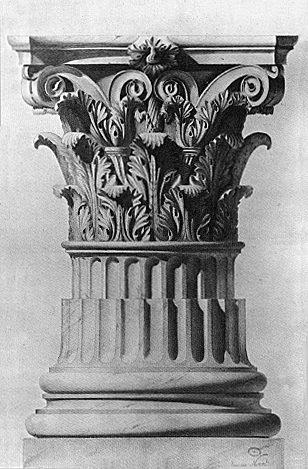

"It [Temple of Mars Ultor] was one of the most perfectly designed and crafted temple structures of the period, employing the Corinthian Order in an orthodox way in terms of proportions, dimensions, and motifs, yet embellishing it with new types of ornamentation that was unique to Roman builders. It was the definitive statement of the Corinthian Order in the first century B.C."
Stamper, The Architecture of Roman Temples (p. 132)
The finest examples of the Corinthian capital are those that still support the architrave of the Temple of Mars Ultor which, for Jones, is the first major building to "display all the vital ingredients of Roman Corinthian proper." The single pilaster, or engaged column, on the right was added because of the irregularity of the back wall. All are made more beautiful by the setting sun.

The architectural drawing on the left is by Louis Noguet (1869), the other by Andrea Palladio (1738). Even more striking than the capitals that surround the temple are those that decorated the interior of the cella, with Pegasuses replacing the volutes.
References: Principles of Roman Architecture (2000) by Mark Wilson Jones; The Architecture of Roman Temples: The Republic to the Middle Empire (2008) by John W. Stamper. The illustrations come from Roma Antiqua: Forum, Colisée, Palatin (1985) by Villa Medici and The Four Books of Architecture (1738/1965) by Andrea Palladio (Dover Reprint).
![]()